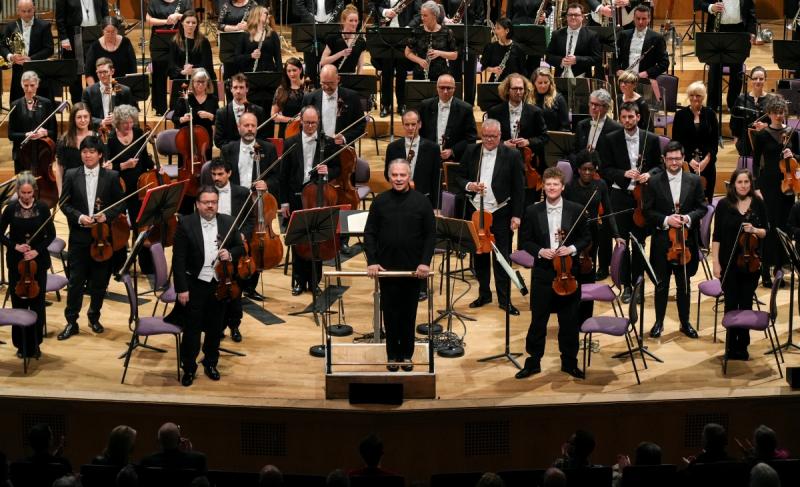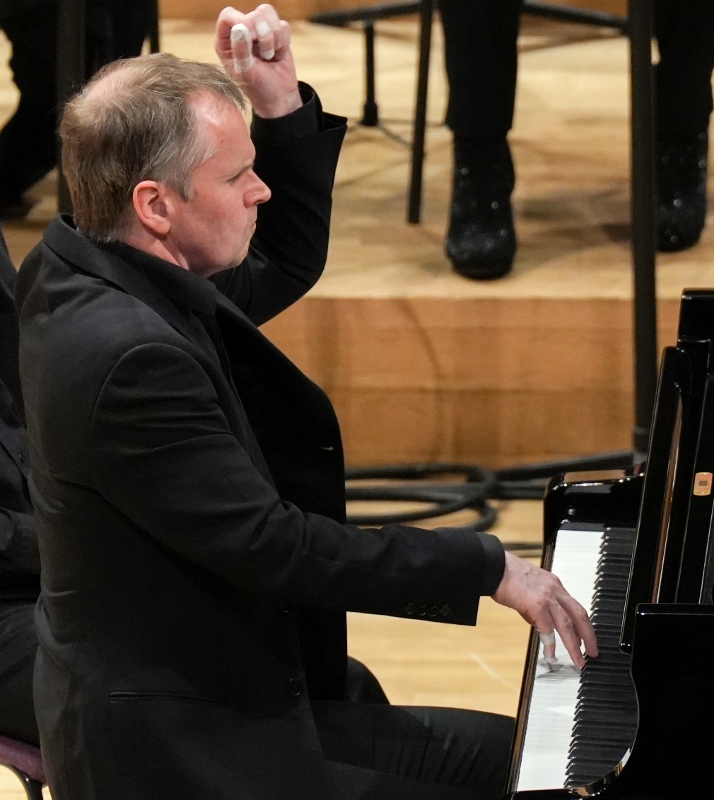Osborne, Hallé, Elder, Bridgewater Hall, Manchester review - an eclectic mix | reviews, news & interviews
Osborne, Hallé, Elder, Bridgewater Hall, Manchester review - an eclectic mix
Osborne, Hallé, Elder, Bridgewater Hall, Manchester review - an eclectic mix
Glory in conclusion of Manchester's Vaughan Williams symphonies cycle

The Mancunian tribute to Ralph Vaughan Williams – a symphonic cycle shared by the BBC Philharmonic and Hallé – reached its conclusion with the Eighth Symphony last night.
First up was Stravinsky. The Concerto for piano and wind instruments is a challenge to the ensemble as much as its soloist, and there was much earnest warming-up, essential to a well tuned and blended wind ensemble, on stage before the start. The music itself, completed in 1924, reflects the rediscovery of north European Baroque textures and techniques of its time, full of counterpoint and sequence, and at times sounding rather akin to the “sewing machine” regularities some have discerned even in J S Bach himself.
 But this is Stravinsky, and nothing is ever what you might expect. Steven Osborne (pictured left), virtuoso pianist and an outstanding product of Manchester musical education, made his modest entry on the scene as the wind players completed a somewhat nervous slow ritornello, but soon began to earn his spurs: the slow central movement, with its thick chords, emerged as a kind of defiant musical iconoclasm dissolving into Chopin-esque delicacy, which he delivered in equal measures. The final quick movement returns to the game playing of the first, as both soloist and ensemble were bursting with energy and enjoying the sheer fun of its jazzy interlude and spirit of send-up.
But this is Stravinsky, and nothing is ever what you might expect. Steven Osborne (pictured left), virtuoso pianist and an outstanding product of Manchester musical education, made his modest entry on the scene as the wind players completed a somewhat nervous slow ritornello, but soon began to earn his spurs: the slow central movement, with its thick chords, emerged as a kind of defiant musical iconoclasm dissolving into Chopin-esque delicacy, which he delivered in equal measures. The final quick movement returns to the game playing of the first, as both soloist and ensemble were bursting with energy and enjoying the sheer fun of its jazzy interlude and spirit of send-up.
Richard Strauss’s Till Eulenspiegels Lustige Streiche followed, taking us back to the last decade of the 1890s and bringing on full “large orchestra” configuration. Repertoire work it may be, but Sir Mark brought many delights, with lilting rhythms and athletic crescendi contrasting with the gentle string sound the Hallé is famed for (led by Alex Robson, who contributed distinguished solos here and in other items in the programme).
Elena Langer’s Suite from her 2016 opera, Figaro Gets a Divorce, has plenty of the spirit of send-up and pastiche, too, as the piece reflects the 20th century Europe Stravinsky knew first-hand. It also gave the strings of the orchestra a chance to shine, with sustained, velvety tone in its opening night-music and lush and thrilling sounds to follow. It’s theatre music taken out of the theatre, but Sir Mark always keeps the sense of drama in such scores and had no need to apologise for its original and atmospheric effects.
And so to Vaughan Williams. John Barbirolli, the Hallé’s principal conductor from 1943 and conductor laureate until his death, had asked Vaughan Williams to write a symphony for him to premiere during his days heading the New York Philharmonic in the 1930s (I’ve seen the cable), and he finally got his wish after 20-odd years in 1956, with the Eighth Symphony, dedicated to him as “Glorious John”. VW was in his 80s by then and wasn’t looking to break any major barriers in his style, but he was still exploring new orchestral sounds and found forms within a four-movement conventional pattern to make a coherent music without a single “proper” sonata structure.
Those of us who remember Glorious John in the flesh can well recall the sight of the throbbing left thumb and the richness of string tone it engendered when we hear the lovely melodic and chordal writing Vaughan Williams gave him in this work, and the inside movements – one for wind alone, one for strings alone – make it something of a demonstration piece for orchestra, too. With two harps to enrich the tapestry, Sir Mark and today’s Hallé were able to weave some glory of their own.
- Broadcast live on Radio 3
- More classical reviews on theartsdesk
rating
Share this article
The future of Arts Journalism
You can stop theartsdesk.com closing!
We urgently need financing to survive. Our fundraising drive has thus far raised £49,000 but we need to reach £100,000 or we will be forced to close. Please contribute here: https://gofund.me/c3f6033d
And if you can forward this information to anyone who might assist, we’d be grateful.

Subscribe to theartsdesk.com
Thank you for continuing to read our work on theartsdesk.com. For unlimited access to every article in its entirety, including our archive of more than 15,000 pieces, we're asking for £5 per month or £40 per year. We feel it's a very good deal, and hope you do too.
To take a subscription now simply click here.
And if you're looking for that extra gift for a friend or family member, why not treat them to a theartsdesk.com gift subscription?
more Classical music
 Jansen, LSO, Pappano, Barbican review - profound and bracing emotional workouts
Great soloist, conductor and orchestra take Britten and Shostakovich to the edge
Jansen, LSO, Pappano, Barbican review - profound and bracing emotional workouts
Great soloist, conductor and orchestra take Britten and Shostakovich to the edge
 Jakub Hrůša and Friends in Concert, Royal Opera review - fleshcreep in two uneven halves
Bartók kept short, and a sprawling Dvořák choral ballad done as well as it could be
Jakub Hrůša and Friends in Concert, Royal Opera review - fleshcreep in two uneven halves
Bartók kept short, and a sprawling Dvořák choral ballad done as well as it could be
 Hadelich, BBC Philharmonic, Storgårds, Bridgewater Hall, Manchester review - youth, fate and pain
Prokofiev in the hands of a fine violinist has surely never sounded better
Hadelich, BBC Philharmonic, Storgårds, Bridgewater Hall, Manchester review - youth, fate and pain
Prokofiev in the hands of a fine violinist has surely never sounded better
 Monteverdi Choir, ORR, Heras-Casado, St Martin-in-the-Fields review - flames of joy and sorrow
First-rate soloists, choir and orchestra unite in a blazing Mozart Requiem
Monteverdi Choir, ORR, Heras-Casado, St Martin-in-the-Fields review - flames of joy and sorrow
First-rate soloists, choir and orchestra unite in a blazing Mozart Requiem
 Cho, LSO, Pappano, Barbican review - finely-focused stormy weather
Chameleonic Seong-Jin Cho is a match for the fine-tuning of the LSO’s Chief Conductor
Cho, LSO, Pappano, Barbican review - finely-focused stormy weather
Chameleonic Seong-Jin Cho is a match for the fine-tuning of the LSO’s Chief Conductor
 Classical CDs: Shrouds, silhouettes and superstition
Cello concertos, choral collections and a stunning tribute to a contemporary giant
Classical CDs: Shrouds, silhouettes and superstition
Cello concertos, choral collections and a stunning tribute to a contemporary giant
 Appl, Levickis, Wigmore Hall review - fun to the fore in cabaret and show songs
A relaxed evening of light-hearted fare, with the accordion offering unusual colours
Appl, Levickis, Wigmore Hall review - fun to the fore in cabaret and show songs
A relaxed evening of light-hearted fare, with the accordion offering unusual colours
 Lammermuir Festival 2025, Part 2 review - from the soaringly sublime to the zoologically ridiculous
Bigger than ever, and the quality remains astonishingly high
Lammermuir Festival 2025, Part 2 review - from the soaringly sublime to the zoologically ridiculous
Bigger than ever, and the quality remains astonishingly high
 BBC Proms: Ehnes, Sinfonia of London, Wilson review - aspects of love
Sensuous Ravel, and bittersweet Bernstein, on an amorous evening
BBC Proms: Ehnes, Sinfonia of London, Wilson review - aspects of love
Sensuous Ravel, and bittersweet Bernstein, on an amorous evening
 Presteigne Festival 2025 review - new music is centre stage in the Welsh Marches
Music by 30 living composers, with Eleanor Alberga topping the bill
Presteigne Festival 2025 review - new music is centre stage in the Welsh Marches
Music by 30 living composers, with Eleanor Alberga topping the bill
 Lammermuir Festival 2025 review - music with soul from the heart of East Lothian
Baroque splendour, and chamber-ensemble drama, amid history-haunted lands
Lammermuir Festival 2025 review - music with soul from the heart of East Lothian
Baroque splendour, and chamber-ensemble drama, amid history-haunted lands
 BBC Proms: Steinbacher, RPO, Petrenko / Sternath, BBCSO, Oramo review - double-bill mixed bag
Young pianist shines in Grieg but Bliss’s portentous cantata disappoints
BBC Proms: Steinbacher, RPO, Petrenko / Sternath, BBCSO, Oramo review - double-bill mixed bag
Young pianist shines in Grieg but Bliss’s portentous cantata disappoints

Add comment